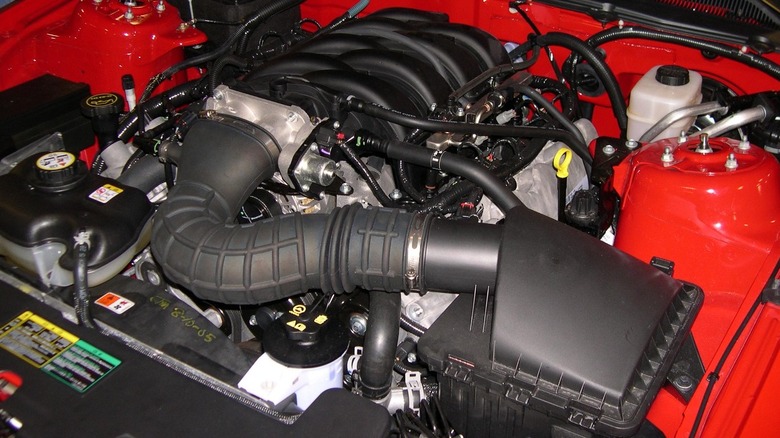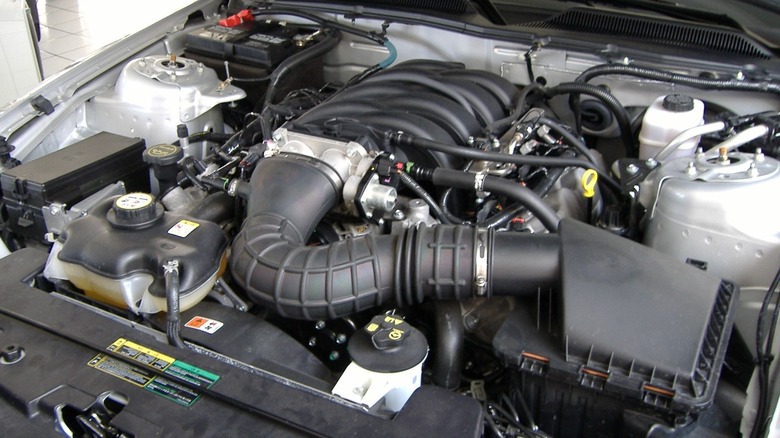Ford 4.6L Engines: What's The Difference Between 2V Vs 3V, And Which Is Better?
Ford's Windsor small-block V8 is often considered one of the best V8 engine series of all time, spanning a 40-year history under the hoods of some of the most successful models in Ford's history including the Mustang, Mercury Cougar, and even the GT40. Despite the Windsor's versatility and success, the small block was an aging design approaching the 1990s. As a result, Ford decided to design an all-new V8 platform to supplement the Windsor V8 called the modular engine series.
The Ford modular series got its name from the unique manufacturing process that Ford used to build the engines, with simplified tooling that allowed for multiple different displacement and cylinder count engines to be manufactured on the same lines without major retooling. This engine family includes V8 and V10 engines ranging from 4.6 to 6.8 liters. In 1991, the first modular engine hit the streets in 4.6-liter form under the hood of a Lincoln Town Car. Unlike the previous Windsor, which was a pushrod V8, the 4.6 modular V8 was a single overhead cam engine. In the beginning, the 4.6L V8 featured two valves per cylinder, often abbreviated as the 4.6L 2V.
As time went on and Ford continued refining the modular platform, they discovered the recipe for better performance — more valves per cylinder. A four-valve version of the 4.6L came next in 1993, utilizing two intake and two exhaust valves. Finally, a three-valve 4.6L was added to the lineup in 2005 under the hood of the S197 Mustang GT, and would continue to power multiple vehicles up until 2010. In total, all variations of the 4.6L V8 powered 13 different Ford models from 1991 until 2014.
[Featured image by Sfoskett~commonswiki via Wikimedia Commons | Cropped and scaled | CC BY-SA 3.0]
What is the difference between the 2V and 3V Ford 4.6L V8 engines?
While the fundamentals of the two-valve and three-valve Ford 4.6L V8 are similar, there are some notable differences between the engines that make the two very different in practice. With both engines sharing a displacement of 4.6 liters, their blocks are interchangeable. The biggest difference between the two can be found in their cylinder heads, which are about as different as they can be.
The 2V 4.6L V8 features a single overhead camshaft cylinder head that utilizes two valves per cylinder, including one intake valve and one exhaust valve. In contrast, the 3V 4.6L V8 utilizes three valves per cylinder, with two intake valves and one large exhaust valve. The 3V also got a revised apex-shaped combustion chamber design that, in combination with the extra intake valve, improved cylinder head flow dramatically. The new cylinder head design increased the 3V's compression ratio to 9.4:1 compared to the 2V's 9.0:1. The spark plugs in the 3V were also centrally located, allowing for a more uniform burn of the incoming air/fuel mixture.
Another major difference is that the 3V 4.6L featured variable camshaft timing, while the 2V did not. The 3V's VCT system used an electronically controlled oil pressure system to advance and retard camshaft timing which improved low end torque and high-end performance while also increasing fuel economy. The VCT system was metered and controlled by an upgraded engine management system compared to the 2V. The 3V's advanced engine management system also allowed for the 3V to switch to an electronic drive-by-wire throttle in place of the 2V's throttle cable.
[Featured image by KarleHorn via Wikimedia Commons | Cropped and scaled | CC BY-SA 3.0]
Is the Ford 4.6L 3V better than the 4.6L 2V?
While the 2V vs. 3V 4.6L debate is often influenced by emotion, it would be hard to argue that the 2V is better than the 3V in any meaningful way. When it comes to factory performance, the 3V wins across the board. Most of that boils down to the additional flow that the 3V cylinder head provides due to its additional intake valve and apex combustion chamber design. That additional performance is delivered through the entire rev range too, as the 3V's variable camshaft timing allows for better low-end and high-end performance simultaneously. In factory form, the 2V maxed out at 260 horsepower in the 2004 Mustang GT, while the 3V peaked at 300 horsepower in the 2009 Mustang GT.
Those benefits in favor of the 3V are the same reasons that the three-valve 4.6L is superior to the two-valve 4.6L when aftermarket modifications are introduced. While both engines have the potential to make massive power, the 2V's more restrictive cylinder heads prevent them from producing high power figures as easily as with a 3V. The two-valve doesn't have a significant cost benefit either, as both two-valve and three-valve 4.6L engines were produced in massive quantities and are easy to find.
[Featured image by Calreyn88 via Wikimedia Commons | Cropped and scaled | CC BY-SA 4.0]


